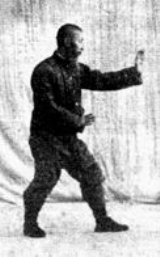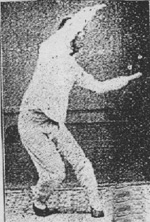
Sun Lu-t'ang
Encyclopedia

Neijia
Nèijiā is a term in Chinese martial arts, grouping those styles that practice nèijìng , usually translated as internal martial arts, occupied with spiritual, mental or qi-related aspects, as opposed to an "external" approach focused on physiological aspects...
(internal) martial arts and was the progenitor of the syncretic
Syncretism
Syncretism is the combining of different beliefs, often while melding practices of various schools of thought. The term means "combining", but see below for the origin of the word...
art of Sun-style tai chi chuan (孫家). He was also considered an accomplished Neo-Confucian and Taoist scholar (especially in the I Ching
I Ching
The I Ching or "Yì Jīng" , also known as the Classic of Changes, Book of Changes and Zhouyi, is one of the oldest of the Chinese classic texts...
), and was a distinguished contributor to the theory of internal martial arts through his many published works.
Biography
He was born in Hebei and was named Sun Fuquan (孫福全) by his parents. Years later, his BaguazhangBaguazhang
Bāguàzhǎng is one of the three main Chinese martial arts of the Wudang school, the other two being Taijiquan and Xingyiquan. It is more broadly grouped as an internal practice...
teacher Cheng Tinghua
Cheng Tinghua
Cheng Tinghua was a renowned master of Chinese Neijia martial art Bagua Zhang.-Biography:Born in the Cheng family village, Shen County, Hebei , he was the third of four brothers....
(程延華) gave him the name Sun Lutang. (It was common in old China for people to have multiple names
Chinese name
Personal names in Chinese culture follow a number of conventions different from those of personal names in Western cultures. Most noticeably, a Chinese name is written with the family name first and the given name next, therefore "John-Paul Smith" as a Chinese name would be "Smith John-Paul"...
). He continued to use his original name in some areas, including the publishing of his books.
He was also well-versed in two other internal martial arts
Neijia
Nèijiā is a term in Chinese martial arts, grouping those styles that practice nèijìng , usually translated as internal martial arts, occupied with spiritual, mental or qi-related aspects, as opposed to an "external" approach focused on physiological aspects...
styles: Xingyiquan
Xingyiquan
Xingyiquan is one of the major "internal" or Wudang styles of Chinese martial arts. The word translates approximately to "Form/Intention Boxing", or "Shape/Will Boxing", and is characterized by aggressive, seemingly linear movements and explosive power...
(Hsing-i ch'uan) and Baguazhang
Baguazhang
Bāguàzhǎng is one of the three main Chinese martial arts of the Wudang school, the other two being Taijiquan and Xingyiquan. It is more broadly grouped as an internal practice...
(Pa Kua Chang) before he came to study T'ai chi ch'uan (Taijiquan). His expertise in these two martial arts were so high that many regarded him as without equal. Sun learned Wu/Hao style t'ai chi ch'uan from Hao Wei-chen
Hao Wei-chen
Hao Wei-chen or was a Chinese t'ai chi ch'uan teacher. Hao became a well known and influential teacher of Wu Yu-hsiang style t'ai chi ch'uan, his teacher Li I-yu was Wu Yu-hsiang's nephew. Hao passed the art to his son and grandson, who became respected teachers in their turn, so that the style...
. Sun started studying with Hao relatively late in his life, but his accomplishments in the other two internal arts led him to develop his t'ai chi abilities to a high standard more quickly than is usual.
He subsequently was invited by Yang Shao-hou
Yang Shao-hou
Yang Shaohou along with Yang Chengfu 楊澄甫 represent the third generation of Yang family taijiquan 楊氏太極拳.At birth he was named Yang Zhaoxiong and was later named Mengxiang, and then Shaohou, commonly known as "Mr...
, Yang Ch'eng-fu and Wu Chien-ch'üan
Wu Chien-ch'uan
Wu Chien-ch'uan , was a famous teacher of the neijia martial art of t'ai chi ch'uan in late Imperial and early Republican China....
to join them on the faculty of the Beijing
Beijing
Beijing , also known as Peking , is the capital of the People's Republic of China and one of the most populous cities in the world, with a population of 19,612,368 as of 2010. The city is the country's political, cultural, and educational center, and home to the headquarters for most of China's...
Physical Education Research Institute where they taught t'ai chi to the public after 1914. Sun taught there until 1928, a seminal period in the development of modern Yang, Wu
Wu style tai chi chuan
The Wu family-style t'ai chi ch'uan of Wu Ch'uan-yu and Wu Chien-ch'uan is the second most popular form of t'ai chi ch'uan in the world today, after the Yang style, and fourth in terms of family seniority. This style is different from the Wu style of t'ai chi ch'uan founded by Wu Yu-hsiang...
and Sun-style t'ai chi ch'uan.
Family
In 1891 he married Zhang Zhouxian, with whom he had three sons and a daughter.- First son, Sun Xingyi (孫星一) (1891-1929)
- Second son, Sun Cunzhou (孫存周) (1893-1963)
- Third son, Sun Huanmin (孫換民) (1897-1922)
- Daughter, Sun Jianyun (孫劍雲) (1913-2003)
Teachers
- XingyiquanXingyiquanXingyiquan is one of the major "internal" or Wudang styles of Chinese martial arts. The word translates approximately to "Form/Intention Boxing", or "Shape/Will Boxing", and is characterized by aggressive, seemingly linear movements and explosive power...
from Li Kuiyuan (李魁元), and later from Guo YunshenGuo YunshenGuo Yunshen was a famous Xingyiquan master. He represented the xingyi martial philosophy of preferring to become highly proficient with only a few techniques rather than to be less proficient with many techniques...
(郭雲深) (from 1882). - BaguazhangBaguazhangBāguàzhǎng is one of the three main Chinese martial arts of the Wudang school, the other two being Taijiquan and Xingyiquan. It is more broadly grouped as an internal practice...
from Cheng TinghuaCheng TinghuaCheng Tinghua was a renowned master of Chinese Neijia martial art Bagua Zhang.-Biography:Born in the Cheng family village, Shen County, Hebei , he was the third of four brothers....
(程延華) (from 1891). - Wu/Hao-style taijiquan from Hao Wei-chenHao Wei-chenHao Wei-chen or was a Chinese t'ai chi ch'uan teacher. Hao became a well known and influential teacher of Wu Yu-hsiang style t'ai chi ch'uan, his teacher Li I-yu was Wu Yu-hsiang's nephew. Hao passed the art to his son and grandson, who became respected teachers in their turn, so that the style...
(郝為眞) (from 1911).
Publications
In later life, he published five martial arts texts:- Xingyiquan xue (A study of form mind boxing) 1915
- Baguaquan xue (A study of eight trigrams boxing) 1916
- Taijiquan xue (A study of grand ultimate boxing) 1921
- Baguajian xue (A study of eight trigrams straight sword) 1927
- Quanyi Shuzhen (An explanation of the essence of boxing)
He also wrote a study of Xingyi spear
Qiang (spear)
Qiang is the Chinese term for spear. Due to its relative ease of manufacture, the spear in many variations was ubiquitous on the pre-modern Chinese battlefield...
, though this was never published.
(These five texts are available in a collected Chinese language edition from Lion Books, and English translations of individual texts can also be acquired)
Legendary Figures
Note: These are legendary or semi-legendary figures in the lineage, which means their involvement in the lineage, while accepted by most of the major schools, isn't independently verifiable from known historical records.

